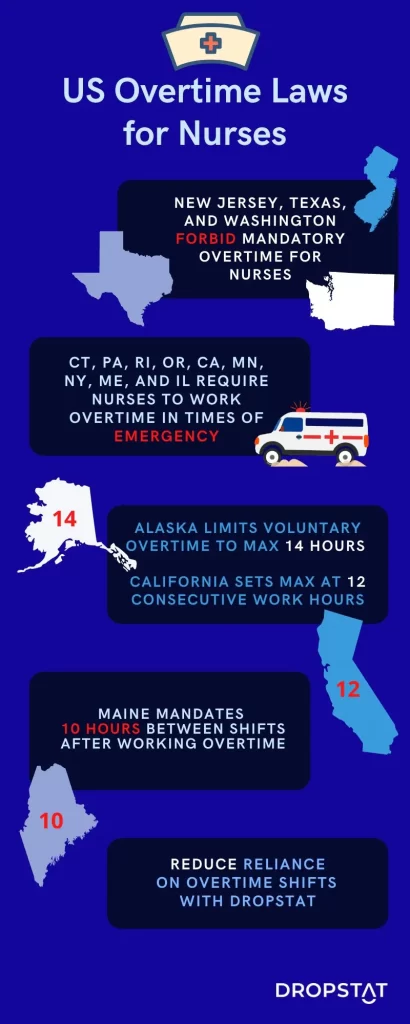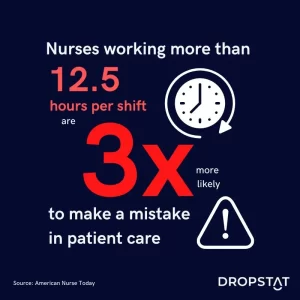The real cost of nurse overtime in patient safety
A nurse working consecutively for more than 12½ hours is three times more likely to make an error (source: American NurseToday). Nurses constantly deal with life and death cases that require quick, decisive actions. A tired nurse working overtime is far more likely to make an error, which can lead to tragedies and lawsuits against healthcare facilities.
The effect on patient satisfaction
A 2012 study by the University of Pennsylvania School of Nursing found that as nurse overtime increases, patient dissatisfaction with care increases. In hospitals with nurses working shifts longer than 13 hours, patients complained that nurses did not communicate well, their pain was not under control, and they did not receive help from nurses when needed.
Working overtime is a hazard to nurses’ wellbeing
Nurses working overtime are putting their health at risk. According to the Bureau of Labor Statistics, in 2020, registered nurses suffered more workplace injuries than construction workers. Additionally, if a nurse has a chronic condition, working overtime will exacerbate it.
Working overtime also leads to nursing burnout and compassion fatigue. Nurses in this state are so mentally and emotionally exhausted that it is impossible for them to feel compassion for their patients. A nurse working overtime will eventually get fed up with working to the point where they will leave their job. This means the facility will need to rely even more heavily on overtime, and nursing turnover rates will spiral out of control.
Overtime is a reality for most nurses
Mandatory overtime for nurses is a widespread problem despite the glaring safety concerns. According to a 2018 Nursing Salary Guide survey, more than half of nursing professionals work compulsory overtime. In hospitals, half of the nurses work shifts longer than 12 hours, and 17% work mandatory overtime.
How much is nurse overtime pay?
Under the FLSA, employees must be paid at least 1.5 times their standard pay rate if they work more than 40 hours a week. Sometimes, nurses get paid cash bonuses in addition to the higher nursing overtime rates mandated by the law. These laws are meant to protect workers and discourage employers from requiring too much overtime.
Mandatory overtime for nurses
Some states have completely outlawed mandatory overtime, and some allow it only in specific circumstances, offering employees greater protection from exploitation.
- New Jersey, Texas, and Washington forbid mandatory overtime for nurses.
- Connecticut, Pennsylvania, Rhode Island, Oregon, California, Minnesota, New York, Maine, and Illinois require nurses to work overtime in times of emergency.
- California forbids working more than 12 hours a day.
- Alaska limits even voluntary overtime to 14 hours.
- Maine has a law that nurses must have 10 hours between shifts after overtime.
Optional overtime in nursing
Despite the benefits, nurse overtime comes with a hefty price tag. Patients, nurses, and employers suffer from mandatory nurse overtime. Healthcare facilities must create a better work environment to benefit both patients and healthcare workers. One solution is to offer overtime only voluntarily.
Before taking on overtime, nurses can ask themselves—do they cope well with long hours and work-related stress? Can nurses work overtime and maintain their health, alertness, mood, and a proper life-work balance? Some young nurses are eager to work overtime and take on premium shifts to pay off student loans. Other nurses prefer to keep a practical, sustainable work schedule.
How much overtime is too much?
The conclusions of many studies concur that shifts should ideally be no longer than 12 hours, and not all nurses will manage such long shifts. You must consider a shift’s physical and psychological demands before asking a nurse to fill a 12-hour shift.
Consider limiting voluntary overtime as well, as nurses working more than 48 hours per week show higher adverse effects and job dissatisfaction from excessive overtime.
Change the attitude about overtime
Nurses feel pressure to work overtime. According to a survey of 170,000 nurses in Ohio, 35% of nurses are uncomfortable voicing opposition when asked to work overtime because they fear losing their job. Some nurses receive threats of being fired or reported to the state licensing board for patient abandonment if they do not agree to work overtime. No one should feel pressured to work overtime, especially if they do not feel up to this challenge.
Strategies to reduce overtime costs
All healthcare facilities should hire enough staff to meet the facility’s needs while considering leaves of absence, time off, vacation time, and unexpected demands. A facility has to be able to overcome the challenges of understaffing without mandating employee overtime. Recruiting more employees won’t only help avoid nurse overtime, but it will significantly increase retention and patient satisfaction.
By assigning staff based on patient care needs, you will have enough staff to work at the regular hourly rate without resorting to mandatory overtime. You will significantly reduce the costs of expensive overtime rates.
The Dropstat solution to control overtime
Dropstat, a healthcare-focused staffing app, is the solution for employers looking to control overtime in their facility. Dropstat helps healthcare facilities fill nursing shifts efficiently and cost-effectively while avoiding expensive last-resort methods like overtime and temporary staffing. The app alerts schedulers to nurses going into overtime and prioritizes regular shift requests to fill shifts with nurses working normal hours – a win from both a safety and cost savings perspective.
Having accurate real-time data about employees’ overtime status is an invaluable tool for establishing a safe and budget-friendly nurse rotation. Dropstat allows medical facilities to effectively prioritize the safety of their patients and employees while reducing overall costs.
In Conclusion: How to combat nurse overtime
We’ve seen how damaging nurse overtime is for patients, nurses, and employers. But what can we do to solve the problem?
- Make the transition from mandatory to voluntary overtime.
- Expand your workforce to decrease reliance on overtime work
- Change the attitude towards overtime in your work culture.
- Monitor your employees’ overtime status before filling shifts blindly
- Treat overtime shifts as an emergency measure – not ideal or routine.
- Ensure your facility supports nurses’ career development and offers competitive salary growth.
- Reward excellent employee performance. Make “excellence bonuses,” giving the opportunity for nurses to make extra cash.
- See how Dropstat can help your facility manage nurse overtime better and plan safer, smarter shift schedules.
Request a demo now to see what the Dropstat difference can look like for your facility!









